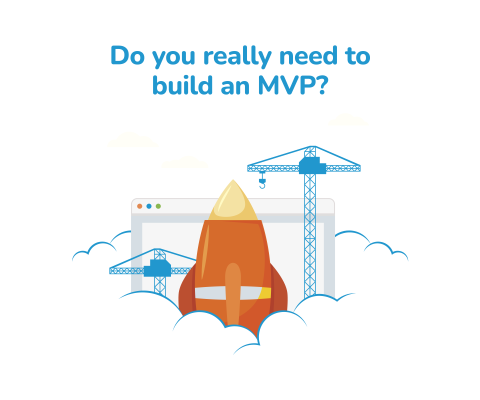December 4th, 2025, posted in for_founders
by Adelina
Delivering a software product from concept to launch is no small feat. Any product owner knows the journey from that first aha! moment to an actual product involves a lot of moving pieces. You have to keep an eye on end goals, internal stakeholders, timelines, features, and everything in-between. It’s like solving a puzzle where the pieces keep changing shape.
This is where product development roadmaps come into place. All of those puzzle pieces start to fit when you’ve clearly outlined every step of your project, accounting for risks and delays and working with your entire team to create a fully accurate plan & timeline.
In this article, we’re going to talk about what a product development roadmap is, and how you can create your own.
What is a product development roadmap?
A product development roadmap covers everything your team needs to achieve in order to deliver the product to market and keep it evolving over time. Think of it as your product’s strategic game plan—it tells your team what you’re building, why you’re building it, and when it’s going to happen.
Similar to a blueprint, it outlines the features, updates, and the overall direction your product development project is heading in. The goal of the product development roadmap is to provide your team with a prioritized plan so everyone can synchronize efforts throughout each stage.
Let’s say you’re building a fitness app. In the first phase, your product development roadmap might focus on core features like tracking workouts and creating a fitness schedule. As your product grows, later phases might introduce more advanced features like integrating with wearables or custom training programs. The roadmap ensures your team has a clear, step-by-step view of what you are trying to achieve at each stage.
Your product roadmap will outline the main features you want to build, so it largely depends on your own business & software needs.
How is a product development roadmap different from other types of roadmaps?
Roadmaps may act as a single source of truth, but they can serve a variety of audiences. It’s true, all roadmaps communicate a company’s strategic thinking and planning, but there are differences between them. So, how is a product development roadmap different from other types of roadmaps?
Product development roadmap: These roadmaps are mainly used by product and engineering teams to stay aligned and keep things moving in the right direction. They detail the different phases of product development, from concept to launch and updates. They include things like technical specifications, features, timelines, and how resources get allocated within the project.
Executive roadmap: These roadmaps emphasize how the team’s work supports big-picture goals like market growth, return on investment, and how the product fits within the company’s overall strategy. These are less about specific features or development milestones, and more about business impact.
Sales roadmap: Designed to support the sales team, these roadmaps highlight new features or products that can be pitched to customers. This helps align sales strategies with the product pipeline, translating new features into customer benefits that can inform sales conversations.
Customer-facing roadmap: Think of it as a public-friendly version of your product roadmap, designed to excite customers about what your product has to offer. These roadmaps should be visually appealing and easy to read, providing a high-level view of what’s to come.
How can a product development roadmap help your team?
Product development is a complex process that involves a lot of steps and people. Without a product development roadmap, teams can quickly lose sight of the bigger picture. The product vision becomes blurry, goals start to shift, and requirements get misunderstood or missed entirely. When everyone is operating in silos or reacting to the latest urgent request, it becomes nearly impossible to prioritize work effectively.
A product development roadmap provides that essential structure and clarity by helping teams:
- Prioritize features that bring the most value to users and work towards a focused product strategy
- Align cross-functional teams and their responsibilities, helping them make better decisions
- Provide better visibility to stakeholders on decisions that are being made
- Help product owners plan and prioritize tasks, ensuring there are no overlaps or gaps in the product development process
- Track progress towards product goals and avoid work that veers away from strategic priorities.
What should you include in a product development roadmap
Product development vision and initiatives: This section answers the big “why”, outlining the purpose of your product and the problems you are trying to solve. These problems can be grouped into broader themes or initiatives that contribute to achieving your product goals. These might include things like “improve onboarding experience” or “enhance mobile performance”.
Features and user stories: These are the actual pieces of work your team should focus on delivering. Break down larger initiatives like “improve onboarding experience” into specific features that map back to your goals (e.g. “add an interactive product tour”). User stories help capture the who, what, and why behind the different product requirements in a simple, clear format (e.g. “As a first-time user, I want an interactive product tour so I can quickly understand main features”).
Timelines and milestones: Timelines and milestones keep everyone aligned about key points along the product development journey, like major release dates, beta launches, or user testing phases. This also allows stakeholders to know when they can expect each stage of the project to be completed.
Dependencies: Identify any roadblocks that might impact your project. Are you waiting on an API from another team? Is there a regulatory review that could delay launch? Including dependencies in your roadmap will help you set more realistic delivery expectations.
Resource allocation: Clearly outline the people, budget, tools, and technology needed to deliver each part of the roadmap. This ensures you have the right team members available, the necessary software or platforms in place, and the budget to support development.
Metrics: Finally, how will you measure success? Many roadmaps include metrics that tie roadmap items to measurable goals like improving retention by 10% or reducing bug reports by 30%.
Key steps to create a product development roadmap
Creating a product development roadmap is no small feat, but there are a few key steps you and your team can follow in order to create one:
-
Map out your goals. What are you building and why? Who are you building for and how will your tool help them? How will this help your business?
-
Define key deliverables. What do you need to build? In software, it’s most likely an app, which will always include: product discovery (figuring out exactly what the app will do, key user flows and desired look & feel), UI/UX design, frontend & backend code, testing & refining.
-
Set a timeline for your work (phases). How long will it take to complete each deliverable? Gather your team and give estimates based on previous experience, similar projects and availability. You can also divide work into phases if you wish to deliver features gradually.
-
Map out required financial, human and technical resources. How many people will you need to work on this project and what are their roles? What’s the cost estimate for each phase of the project? Are there any major technical requirements such as APIs, tools or plugins? This is a good point to assign work to specific employees, such as project management, design and development.
-
Evaluate & refine. You won’t be working on your project alone, and thus you need to leave space for your team’s input for the roadmap as well. Involve all key roles and ensure the project timeline is doable (especially the code work), that the financial estimates are accurate and that your required team members are available and equipped.
Once you’re done creating your project roadmap, you’re successfully outlined all project components & requirements and thus can start making Kanban boards and assigning specific tasks.
In need of your own product development roadmap? Let’s talk about your project and we can create one for you, totally for free.

















